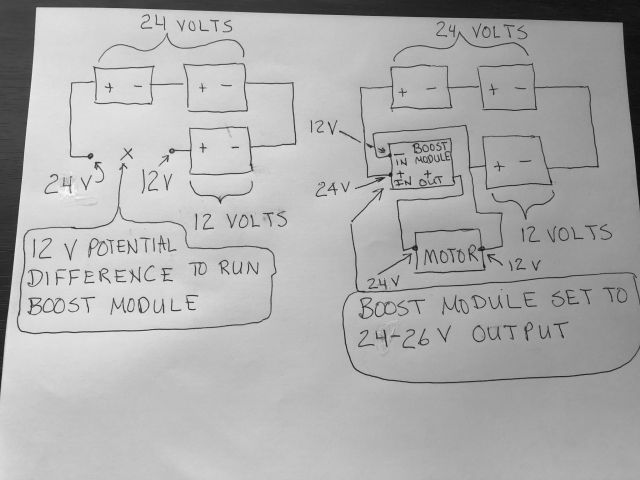3 Battery by David Bowling

3 Battery Generating System
Kone,
You can create potential differences by running a boost
module on a single battery and setting the output voltage above 24 volts. Now you have
potential difference between the boost module output and the only battery. If you have
batteries, put a couple in series to get the 24 volts to work with.
You should
get Bob French on your forum. I have worked with Bob for a long time. I helped him
with the potential difference stuff, and he built systems for his little off the grid
place where he would run between the positives like that and basically use the same
energy five times before recharging his batteries off his solar panels. I did the same
kind of thing with my dad. You can really extend the use you get out of a very small
solar setup. Itís all about running everything between the potentials. Nothing to
ground if you can help it.
David
Hi David, can you draw a diagram of
the potential difference between the batteries and the boost module? Does the idea
come from the
John Bedini 3 battery circuit?
Best Wishes, Hermes
Hermes,
Saying the current research on the potential difference stuff came from
John Bedini is like saying the 747 came from the Wright Brothers. John posted a 3
battery circuit years and years ago that ham radio operators used to charge
(I believe) 1V batteries by rotating the batteries relative to a small bulb. It proves
a concept. It wasn't his idea, he was passing it along. That's basically all he did
with it as far as I have been able to find.
He posted a circuit. He DID make
use of the potential difference "concepts" in his famous
"Tesla switch", but the prior work on
that was done by
Carlos Benitez. We all build on those that went before, and John was no exception.
I am not attempting to belittle John. If not for his work in the free energy field,
many of those currently involved would probably not be here, including ME.
But
I simply find no evidence that he did research on the 3 battery stuff simply because
in order to get it to work correctly you had to have a load so low that the batteries
could recover on their own. Not much practical use. BUT, understanding potentials and
how to use them IS the key, and John's Tesla switch brought that into the light in a
way Benitez was never able to do in
his time. The concept has been around for a long time and using potentials to do work
while recovering some or MOST of the energy put through the circuit is a reality that
more people need to explore. I fully believe it is the key to free energy.
Attached is a drawing of what I had running in the video. The two primary batteries
are going to discharge, with the one closest to the motor discharging the fastest. The
third battery, which is all by itself, is going to charge. This is NOT an overunity
circuit. The impedance to charge in the 3rd battery and the inefficiency of the boost
module insure that it won't be, but you CAN see that energy is recovered and you CAN
see that you get extended run times out of the three batteries if they are rotated.
It is best, when using lead acid batteries, to have FIVE batteries in the
rotation with 2 always resting and recovering from being charged or discharged. If you
follow Battery 1 through the rotation it is Discharging, then Discharging, then
Resting, then Charging, then Resting, then back to the beginning where it is
Discharging again.
By the way, DC to DC converters can be run the same way
(between the potentials) and for some reason seem to be more efficient than boost
modules. Possibly the input and output of a DC to DC converter are inductively coupled
like a transformer instead of electrically coupled like a boost module. I'm not sure.
I honestly have not explored it, and probably do not know enough about electronics to
figure it out.
[ Battery 1]----[ Battery 2]---(REST)---([Motor]---
[Battery 3]---(REST)---Then back to the Battery 1 position
David
back to linkpage
suggestion
read and sign my guestbook

